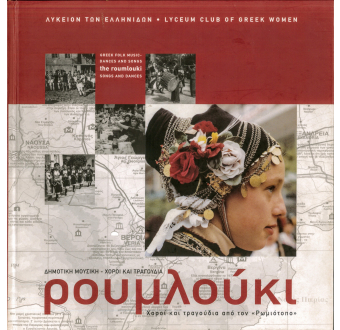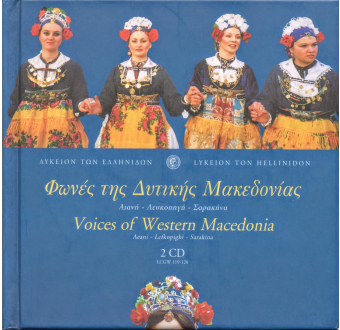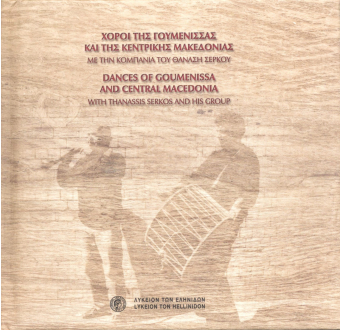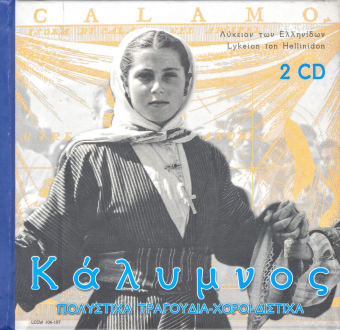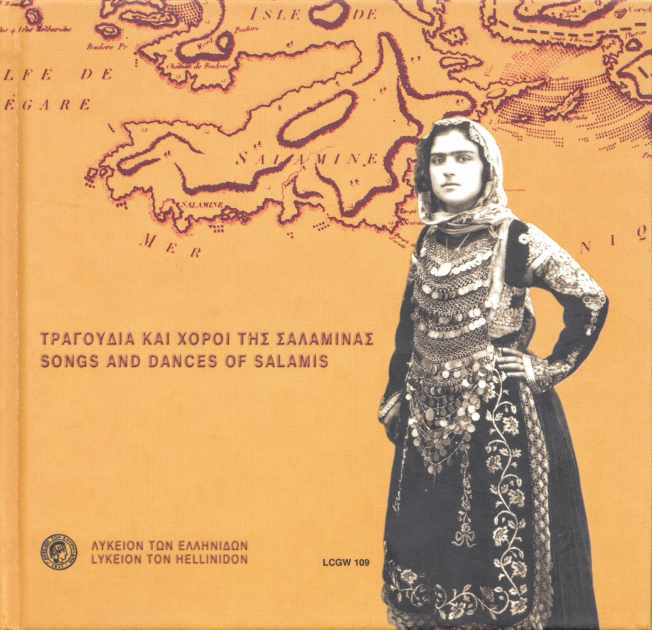
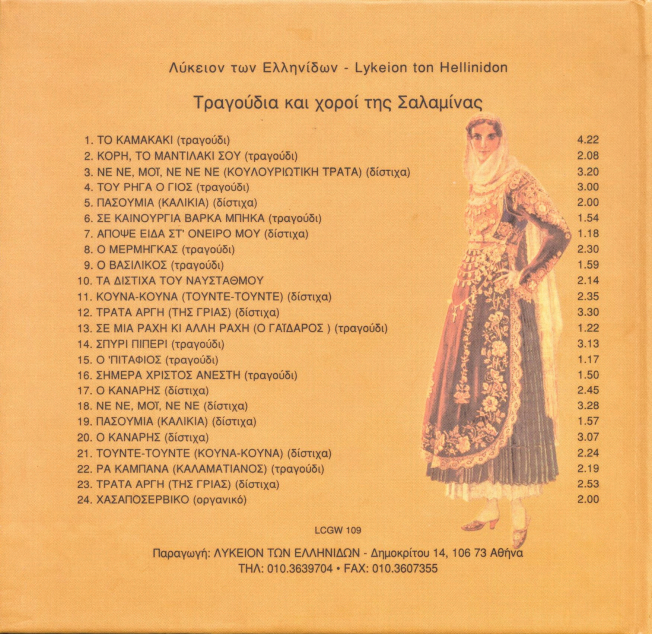
Songs and dances from the rich traditional lore of the famous and historic island of Salamis make up this recording.
The songs and dances included in this disk are mainly those of the Carnival and Easter seasons. Some of the songs were sung in Greek, others used to be sung in “Arvanitika”, the local Albanian dialect, while in others, both languages were used, since, until the beginning of the Second World War, the Albanian language was widely spoken on the island. Today, very few of the inhabitants speak or sing in “Arvanitika”.
Already, since the 15th century, Salamis had, to a great degree, become Albanian-speaking, without, however, losing its ethnic character. The presence of an Albanian population in Attica has been established since the period of Frankish rule. The first settlers arrived at the time of Don Pedro of Aragon, when he, as Duke of Athens, in 1382, issued a decree permitting the installation of new settlers in the fallow and deserted region of Attica. From then on, and until the middle of the 16th century, successive waves of migrants moved down from the north and settled, not only in Attica, but also in various parts of Southern Greece, from Locris to the Peloponnese and to various offshore islands, such as Salamis.
Tough and hardy, good and experienced warriors, stubborn, dependable, reserved, conservative, firmly attached to their traditions, hard-working and patient, divided into clans with different customs and local variants in dialect, these Albanian-speaking populations, imbued with a strong Greek consciousness, gradually encircled Athens -ever- alert guardians of their homeland- bringing new life to the formation of the character of modern Attica. From this time on, the Albanians will play one of the principal roles in the Athenian adventure. This time, the melting-pot will have done a good job.
George and Lambros Coromilas: The Athenian Adventure, Athens 1981
The material in this recording is based on the two main and best-known dances of Koulouri (the island’s popular name, from its round shape: “koulouri: - a ring-shaped biscuit), the “Trata” dances. This appellation is probably a fairly recent one. In older times the name “Valle'' covered all the types of communal dances performed in the region. The types of “Trata” dances in Salamis are mainly two:
a. The “sta tria” movement (step r.l.r. point-or raise-left ft., step left, point-or raise- right ft.) which is one of the oldest Greek folk dances, and one of Panhellenic character, since there is not a single community in Greece without some kind of variation of this kinetic pattern.
b. the local “trata” step, resembling that of Megara, but executed according to a particular Salaminian variation.
The musical instruments used were the violin, the lute, the sandouri (dulcimer) and, to a lesser extent, the clarinet. In older times, the lyra and “pipiza” (a kind of flute) were also used, but these fell into disuse at the beginning of the 20th century. The dances performed on important feast days, on the beach of the town of Salamis called “Armyreza”, were not accompanied by musical instruments, but by songs which were special for each occasion. The local musicians were called upon to play on unofficial festive occasions, at private gatherings, weddings and at coffee shops, on Sundays or less important holidays.
The melodies and couplets of the “Valle” of Salamis, which were traditionally sung at the Carnival or Easter time, were familiar to all, something which is no longer the case, today. The women singers - two on either end of the dance line - were the ones who carried the musical burden of the dance.
Nowadays, it is difficult to find people who will undertake this task. Communal dances not having been held for a long time, a great many of the old songs have been lost, a phenomenon which is not peculiar to Salamis but is common to all the other parts of Greece, today. The traditional regional repertoire has grown noticeably poorer, owing to the lack of local folk musicians. On feast days and festive occasions, the Salaminians dance to the tunes with which most Greeks are familiar: the “kalamatianos”, the “ballos” of the Aegean Islands, and the “syrtos” and “tsamikos” danced on the mainland. The big community dances, with their characteristic local colour, are no more. Only in recent years has an attempt been made to revive them, at great cost, by the Municipality and the Lyceum Club of Greek Women of Salamis, who have spared no effort in this direction.
The musicians taking part in this recording are the well know Athenian folk players, Alekos Arapakis, Vassilis Katrakos, Nikos Karatassos and Sotiris Koudemanis, who have often performed at Salaminian parties and festivities all over the island.
The assistance of the Administrative Board of the Lyceum Club of Greek Women of Salamis has been invaluable and determinative, as has been that of the dance group’s coach and teacher, Glafkos Harmandas. The participation of Mmes Kiki Biniari, Assimo Leni, Eleni Santou, Vangelio Sarakini and Zoe Telemachou must also be specially mentioned. The recording of these songs would not have been possible without their warm interest and eager cooperation.
Athens, November 1991
Lefteris Drandakis
1. To kamakaki (The fishing spear) (Song) 4.22
2. Kori, to mandilaki sou (Maiden, your kerchief) (Song) 2.08
3. Ne ne, moy, ne ne ne (Trata of Koulouri) (Couplets) 3.20
4. Tou Righa o yios (The King’s Son) (Song) 3.00
5. Ta Passoumia (Ta kalikia) (The Slippers) (Couplets) 2.00
6. Se kainouria varka bika (In a new boat I embarked) (Song) 1.54
7. Apopse eida st’ oniro mou (Last night I saw in my dream) (Couplets) 1.18
8. O mermingas (The Ant) (Song) 2.30
9. O Vassilikos (The Sweet Basil Plant) (Song) 1.59
10. Ta disticha tou nafstathmou (The Naval Base couplets) 2.22
11. Kouna-Kouna (Swing it swing it) (Couplets) 2.35
12. Slow trata (The Old Woman’s Trata) (Couplets) 3.30
13. Se mia rachi ki alli rachi (On a hill, that hilltop yonder) (Song) 1.22
14. Spyri piperi (Pepper Seed) (Song) 3.13
15. O ’Pitaphios (Lament on the Burial of the Lord) (Song) 1.17
16. Simera Christos Anesti (Today Christ is risen) (Song) 1.50
17. O Kanaris (Coulpets) 2.45
18. Ne ne, moy, ne ne (Trata of Koulouri)* (Couplets) 3.28
19. Ta Passoumia (Ta kalikia) (The Slippers)* (Couplets) 2.01
20. O Kanaris* (Coulpets) 3.10
21. Tounde-Tounde (Kouna-Kouna) (Swing it swing it)* (Couplets) 2.24
22. Ra Kambana E Papandise* (Song) 2.19
23. Slow trata*(The Old Woman’s Trata) (Couplets) 2.53
24. Hasaposerviko* (Instrumental) 2.05
Note: Items marked with an asterisk* are new additions
Violin: Alekos Arapakis (Psachna, Euboea, 1921)
Sandouri: Nikos Karatassos (Piraeus, 1931)
Lute: Vassilis Katrakos (Taxiarches, Kymi, Euboea, 1939)
Toumbeleki: Sotiris Koudemanis (Megara, 1965)
Singers:
Assimo Rammou-Leni (Salamis, 1928)
Kiki Kiamili-Biniari (Salamis, 1937)
Eleni Santou (Salamis, 1931)
Vangelio Eustathiou-Sarinaki (Salamis, 1927)
Zoe Koupetori-Telemachou (Salamis, 1932)
Group of Salaminian women: Tania Beri, Effy Boutsi, Evi Lekka, Katerina Liouli, Anna Maniati, Anna Michalaki, Maria Michalaki, Christina Poutou, Demetra Sakellariou, Sosso Sakellariou, Maria Theodossi, Frosso Vassiliou, Jenny Vassiliou.
The recordings of these songs, took place on the premises of the Lykeion ton Hellinidon of Salamis (Salamis November 1990) using a NAGRA IV STEREO recorder, at the ERA STUDIO (Athens January 1991), and at STUDIO C of ERT Inc. (Greet RTV), (Athens October 1992). Included in the present CD are a number of tunes with bilingual lyrics, "Arvanitika" and Greek couplets, which were recorded then but which had to be left out in the 1991 LP (LCGW 109) because of the limited recording time.
Recorded by: Yannis Sygletos




